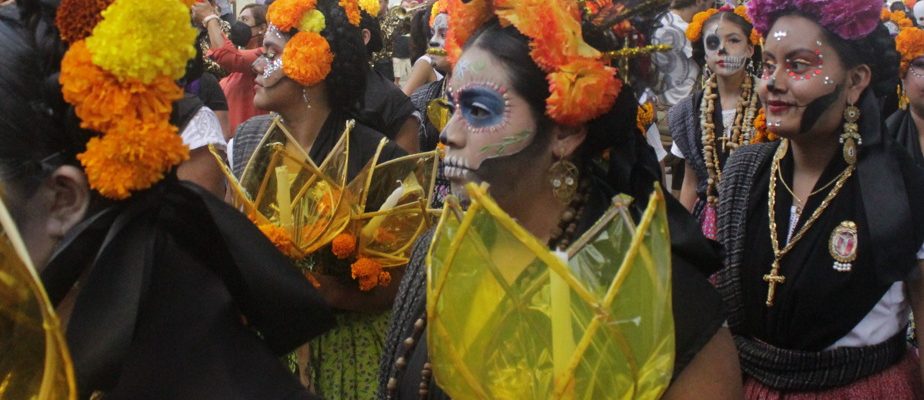The streets of Oaxaca are adorned with color, while a multitude of shows attest to the cultural growth of this city in southern Mexico. “The Day of the Dead includes features from different indigenous traditions in Mexico,” says art historian Andrea Almogabar. The coexistence of several cultures is what makes Oaxaca unique. »
A syncretism with the Catholic religion also defines All Souls Day. “The traditional altar comes from a Zapotec tradition, while various elements come from Nahuatl culture and many others,” notes Andrea Almogabar. It is a cultural fusion like Mexico. »
With the title “ Oaxaca long live, nunca muere » (Oaxaca Always Lives and Never Dies), the festival mainly features public art exhibitions, music performances and theater works. Every year, costume parades called compare Or dead are among the most popular gatherings surrounding All Souls Day.

PHOTO PROVIDED BY ALEXIS LAPOINTE
The streets of Oaxaca are adorned with color for the Day of the Dead festivities.
In particular, there is the participation of an internationally recognized dance troupe, that of the Chinas Oaxaqueñas Genoveva Medina. “We joined these festivities 12 years ago with the objective of honoring indigenous cultures,” says Miguel Tejero, choreographer of the troupe. We represent a deeply mixed story. »
Essential cosmovision
“Traditions that celebrated death were present in Mesoamerican cultures before the arrival of European settlers,” explains Andrea Almogabar. This is truly where the origin of Day of the Dead lies. »

PHOTO PROVIDED BY ALEXIS LAPOINTE
The rich heritage of the region is expressed, among other things, in wall art.
She notes that these cultures keep echoes alive in Mexico. “We have a greater awareness of death and we know that it is part of daily life, whereas it represents a taboo in Western thought,” she emphasizes. We honor it to celebrate life, and perhaps that is why we have a celebratory culture. »
This awareness also implies a recognition of the ephemeral nature of life.

PHOTO PROVIDED BY ALEXIS LAPOINTE
Andrea Almogabar, art historian
The feather of a quetzal, considered the most beautiful bird, was worth more than gold in Nahuatl culture. It was the ephemeral beauty of its colors that gave it its value.
Andrea Almogabar, art historian
Moreover, the art historian sees it as a current inspiration. “The people of pre-Hispanic times were dedicated to agriculture in the region where we live, and that is what defined their cosmovision,” she says. This rather denotes a relationship of belonging to nature, and this vision contrasts with the anthropocentrism advocated by the Church. »

PHOTO PROVIDED BY ALEXIS LAPOINTE
THE zócalo (central square) of the city of Oaxaca, with an ornamentation of flowers cempasúchiltypical of the Day of the Dead.
At a time when the defense of the planet is becoming a vital issue, this is a legacy in which we can see a form of subversion. Andrea Almogabar sees it as a call to awakening. “The meaning of this tradition must be preserved,” she believes. When we share it with strangers, we want to do so in the context of respectful exchanges. »
As an art historian, she is called upon to discover the traditions linked to these celebrations in different contexts. For example, these days she leads tours to Mitla, a magnificent archaeological area that represented the “Valley of the Dead” for the Zapotecs. “There is much more than a spectacle in these cultures,” she says. It is a contemporary heritage, complex and belonging to the people who carry it on a local scale, so it deserves to be well honored. »
Current movements
“These traditions lead us to connect to our heritage and give it contemporary life,” adds Amarildo Omeldo, an artist known for his work with the workshop he runs in Yahuiche, a town on the outskirts of Oaxaca. This is what I do with mask art. »

PHOTO PROVIDED BY ALEXIS LAPOINTE
Amarildo Olmedo’s mask-making workshop in Yahuiche, Oaxaca
With a collective of artists from Yahuiche, the locality where he set up his workshop, he chose to devote himself fully to this form of creation established around thirty years ago. “This is an initiative by the artist Cecilio Sánchez, also from Yahuiche,” he says. This plastic orientation that he defended comes from the connection between popular history and vivid expression. »
He notes that Cecilio Sánchez worked with Rufino Tamayo, an artist from Oaxaca who is among the essential names in the history of art in Mexico. “There is a spirit of resistance in the culture of Day of Muertos, affirms the artist. We share our art on a community level and we wear masks in the compare and the muerteadas. »
